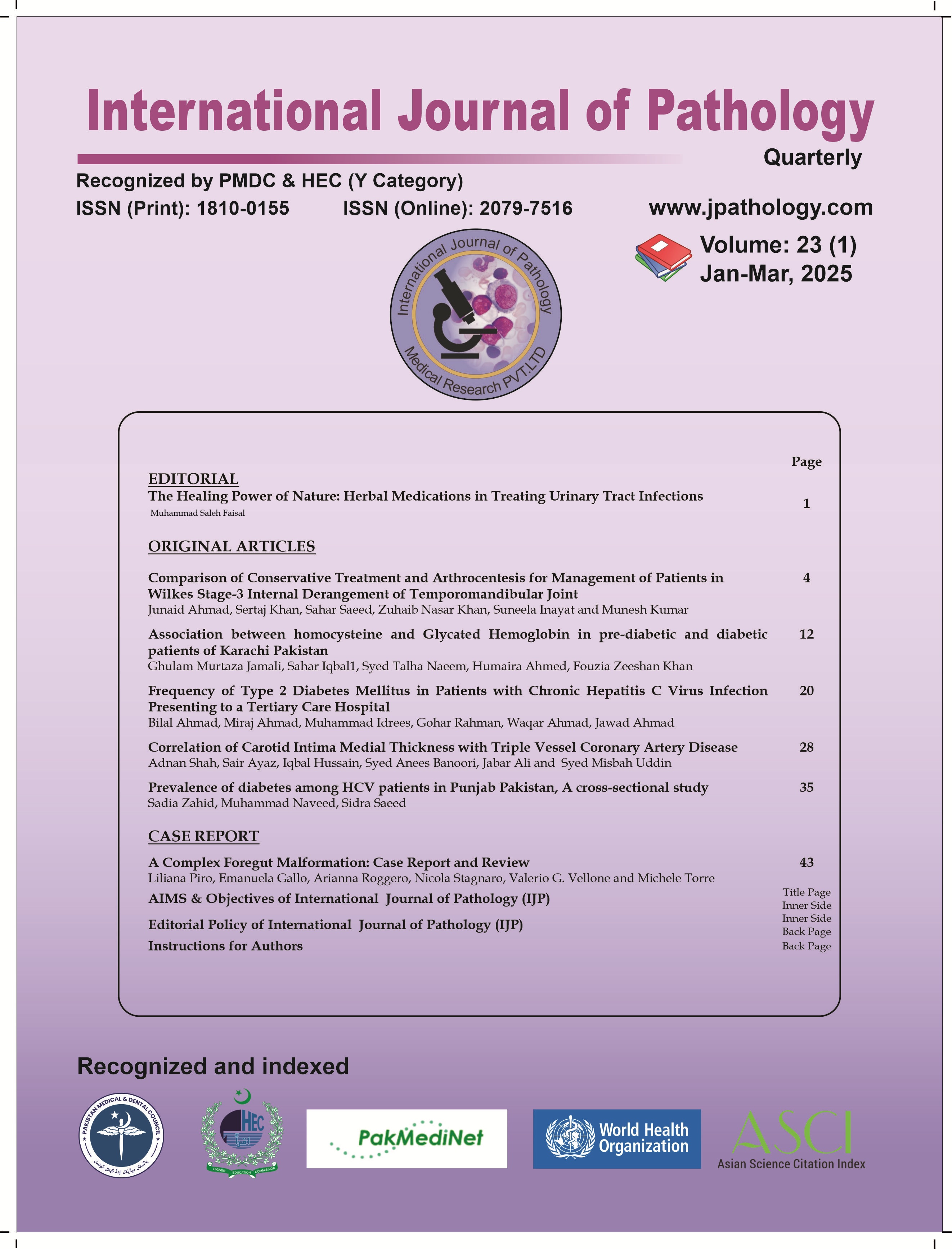Prevalence of HCV induced diabetes among HCV patients in Punjab Pakistan, A cross-sectional study
DOI:
https://doi.org/10.59736/IJP.23.01.934Keywords:
HCV (Hepatitis C virus), PCR (polymerase chain reaction), ELISA (enzyme linked immuno sorbant assay)Abstract
Background: With a high disease burden, hepatitis C virus (HCV) disorders are one of Pakistan's top public health concerns. Despite the country's access to efficient antiviral medications, the overall population's disease burden has not decreased. This may be due to the infection's asymptomatic character, which makes it difficult to diagnose until late in the course of symptoms. A population-based analysis is required for an efficient control of the virus in order to more precisely figure out and identify HCV infections in the nation.
Methods: In our study, 2000 HCV samples were collected from different regions of Punjab and tested for HCV by Bioline™ HCV kit for early detection and Fasting blood glucose level was determined by glucometer to check diabetes. Then all HCV positive samples sent to Genome center for molecular based diagnostics & research (GCMD) Lahore, where samples were confirmed by PCR and diabetes was confirmed by HbA1c test for HCV induced diabetes confirmation. The objective of this study is to find out the overall prevalence of HCV induced diabetic samples among HCV positive patients. Viral load, Hemoglobin levels and platelets count were other factors analyzed in this research contributing to the effective prevention, control and treatment to control HCV induced diabetes prevalence in the province of Punjab Pakistan.
Results: Overall, 80% of the samples were detected as HCV positive and HCV induced diabetic samples were 9% that were identified in this study. A significant difference in prevalence of HCV induced diabetes was observed in different age groups among (male and female) with 57% male and 43% female patients.
Conclusion: This study represents the prevalence of HCV induced diabetes among HCV infected patients of about 9% (age 22-72 years) from different regions of Punjab.
References
But DY, Lai CL, Yuen MF. Natural history of hepatitis-related hepatocellular carcinoma. World J Gastroenterol. 2008 Mar 21;14(11):1652-6. doi: 10.3748/wjg.14.1652.
Choo QL, Kuo G, Weiner AJ, Overby LR, Bradley DW, Houghton M. Isolation of a cDNA clone derived from a blood-borne non-A, non-B viral hepatitis genome. Science. 1989 Apr 21;244(4902):359-62. doi: 10.1126/science.2523562.
Kandeel A, Genedy M, El-Refai S, Funk AL, Fontanet A, Talaat M. The prevalence of hepatitis C virus infection in Egypt 2015: implications for future policy on prevention and treatment. Liver Int. 2017 Jan;37(1):45-53. doi: 10.1111/liv.13186.
Mohd Hanafiah K, Groeger J, Flaxman AD, Wiersma ST. Global epidemiology of hepatitis C virus infection: new estimates of age-specific antibody to HCV seroprevalence. Hepatology. 2013 Apr;57(4):1333-42. doi: 10.1002/hep.26141.
Organization WH. Global hepatitis report 2017: World Health Organization; 2017.
Strader D, Wright T. Global Burden of Disease for hepatitis C. J Clin Pharmacol. 2004;44:20-9.
Wroblewski LE, Peek RM Jr. Helicobacter pylori: Pathogenic enablers - toxic relationships in the stomach. Nat Rev Gastroenterol Hepatol. 2016 Jun;13(6):317-8. doi: 10.1038/nrgastro.2016.68.
Thrift AP, El-Serag HB, Kanwal F. Global epidemiology and burden of HCV infection and HCV-related disease. Nat Rev Gastroenterol Hepatol. 2017 Feb;14(2):122-32. doi: 10.1038/nrgastro.2016.176.
Butt S, Idrees M, Akbar H, ur Rehman I, Awan Z, Afzal S,et al. The changing epidemiology pattern and frequency distribution of hepatitis C virus in Pakistan. Infect Genet Evol. 2010 Jul;10(5):595-600. doi: 10.1016/j.meegid.2010.04.012.
Zhang CG, Zhang B, Deng WS, Duan M, Chen W, Wu ZY. Role of estrogen receptor β selective agonist in ameliorating portal hypertension in rats with CCl4-induced liver cirrhosis. World J Gastroenterol. 2016 May 14;22(18):4484-500. doi: 10.3748/wjg.v22.i18.4484.
Lavanchy D. Evolving epidemiology of hepatitis C virus. Clin Microbiol Infect. 2011 Feb;17(2):107-15. doi: 10.1111/j.1469-0691.2010.03432.x.
Tang L, Marcell L, Kottilil S. Systemic manifestations of hepatitis C infection. Infect Agent Cancer. 2016 May 23;11:29. doi: 10.1186/s13027-016-0076-7.
Vanni E, Bugianesi E, Saracco G. Treatment of type 2 diabetes mellitus by viral eradication in chronic hepatitis C: Myth or reality? Dig Liver Dis. 2016 Feb;48(2):105-11. doi: 10.1016/j.dld.2015.10.016.
Kaddai V, Negro F. Current understanding of insulin resistance in hepatitis C. Expert Rev Gastroenterol Hepatol. 2011 Aug;5(4):503-16. doi: 10.1586/egh.11.43.
Pazienza V, Vinciguerra M, Andriulli A, Mangia A. Hepatitis C virus core protein genotype 3a increases SOCS-7 expression through PPAR-{gamma} in Huh-7 cells. J Gen Virol. 2010 Jul;91(Pt 7):1678-86. doi: 10.1099/vir.0.020644-0.
Persico M, Russo R, Persico E, Svelto M, Spano D, Andolfo I, et al. SOCS3 and IRS-1 gene expression differs between genotype 1 and genotype 2 hepatitis C virus-infected HepG2 cells. Clin Chem Lab Med. 2009;47(10):1217-25. doi: 10.1515/CCLM.2009.280.
Milner KL, van der Poorten D, Trenell M, Jenkins AB, Xu A, Smythe G, et al. Chronic hepatitis C is associated with peripheral rather than hepatic insulin resistance. Gastroenterology. 2010 Mar;138(3):932-41.e1-3. doi: 10.1053/j.gastro.2009.11.050.
Idrees M. Development of an improved genotyping assay for the detection of hepatitis C virus genotypes and subtypes in Pakistan. J Virol Methods. 2008 Jun;150(1-2):50-6. doi: 10.1016/j.jviromet.2008.03.001.
Ali A, Nisar M, Ahmad H, Saif N, Idrees M, Bajwa MA. Determination of HCV genotypes and viral loads in chronic HCV infected patients of Hazara Pakistan. Virol J. 2011 Oct 9;8:466.
Zahid S. A Molecular Based Approach to Characterize Untypable HCV Genotype. Int J Pathol . 2021 Mar. 30;18(4):128-35.
Rafique S, Zahid S, Ali A, Tariq M, Saeed M, Iqbal Sahibzada K,et al. Genome-wide methylation profiling of HCV pathogenesis to develop diabetes and diabetic complications. J Viral Hepat. 2021 Feb;28(2):245-259. doi: 10.1111/jvh.13417.
Ndako, J.A., Owolabi, A.O., Olisa, J.A. et al. Studies on the prevalence of Hepatitis C virus infection in diabetic patients attending a tertiary health-care facility South-west Nigeria. BMC Infect Dis 20, 664 (2020).
Mason AL, Lau JY, Hoang N, Qian K, Alexander GJ, Xu L, Guo L, Jacob S, Regenstein FG, Zimmerman R, Everhart JE, Wasserfall C, Maclaren NK, Perrillo RP. Association of diabetes mellitus and chronic hepatitis C virus infection. Hepatology. 1999 Feb;29(2):328-33. doi: 10.1002/hep.510290235.
Ndako JA, Owolabi AO, Olisa JA, Akinwumi JA, Dojumo VT, Olatinsu O, Adebayo BA. Studies on the prevalence of Hepatitis C virus infection in diabetic patients attending a tertiary health-care facility South-west Nigeria. BMC Infect Dis. 2020 Sep 9;20(1):664. doi: 10.1186/s12879-020-05388-7. PMID: 32907538; PMCID: PMC7488326.
Ndako JA, Echeonwu GON, Shidali NN, Bichi IA, Paul GA, Onovoh E, Okeke LA. Occurrence of Hepatitis C Virus infection in type 2 diabetic patients attending Plateau state specialist hospital Jos Nigeria. Virol J. 2009;6:98. https://doi.org/10.1186/1743-422X-6-98.
Demitrost L, Ranabir S. Thyroid dysfunction in type 2 diabetes mellitus: A retrospective study. Indian J Endocrinol Metab. 2012;16(Suppl 2):S334–5.
Shams F, Rafique S, Zahid S, Munir M, Idrees M, Ilyas M,et al. Advances in the role of HCV nonstructural protein 5a (NS5A) of 3a genotype in inducing insulin resistance by possible phosphorylation of AKT/PKB. Sci Rep. 2019 Apr 16;9(1):6150. doi: 10.1038/s41598-019-42602-2.
Downloads
Published
Issue
Section
License
Copyright (c) 2025 Sadia Zahid, Muhammad Naveed, Sidra Saeed

This work is licensed under a Creative Commons Attribution-NonCommercial 4.0 International License.
Readers may “Share-copy and redistribute the material in any medium or format” and “Adapt-remix, transform, and build upon the material”. The readers must give appropriate credit to the source of the material and indicate if changes were made to the material. Readers may not use the material for commercial purpose. The readers may not apply legal terms or technological measures that legally restrict others from doing anything the license permits.


